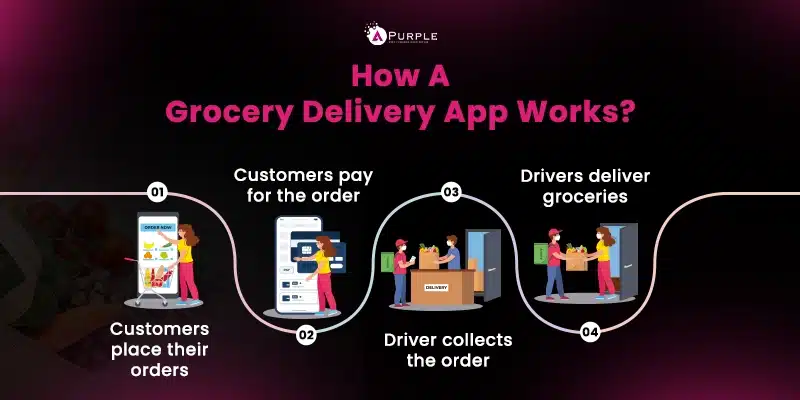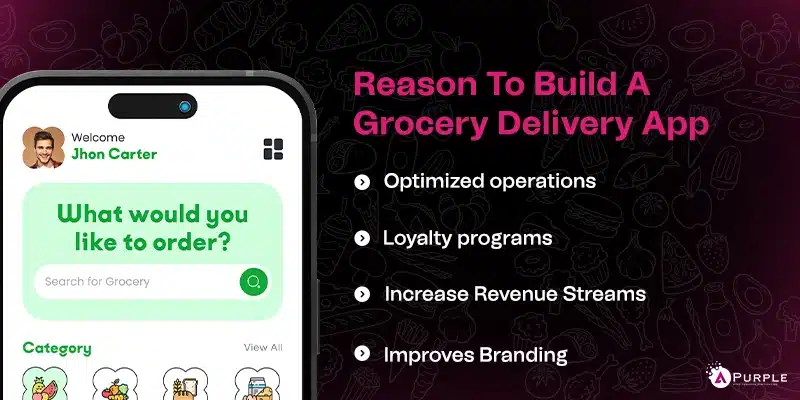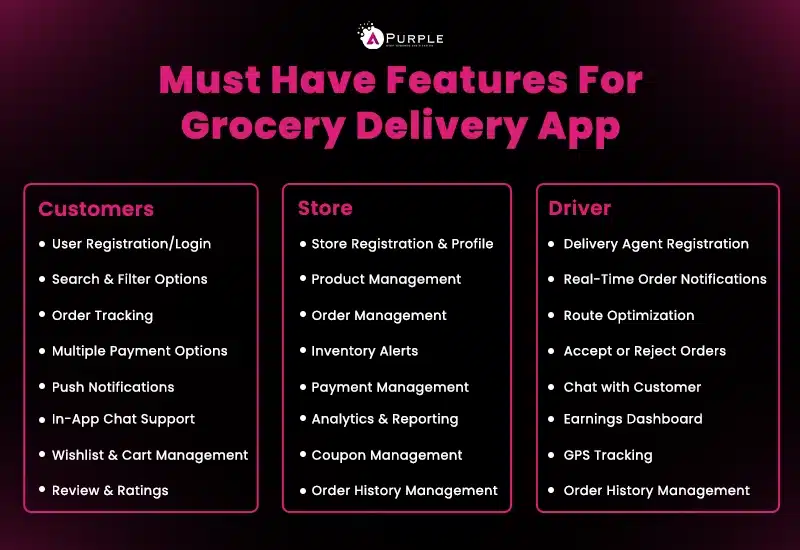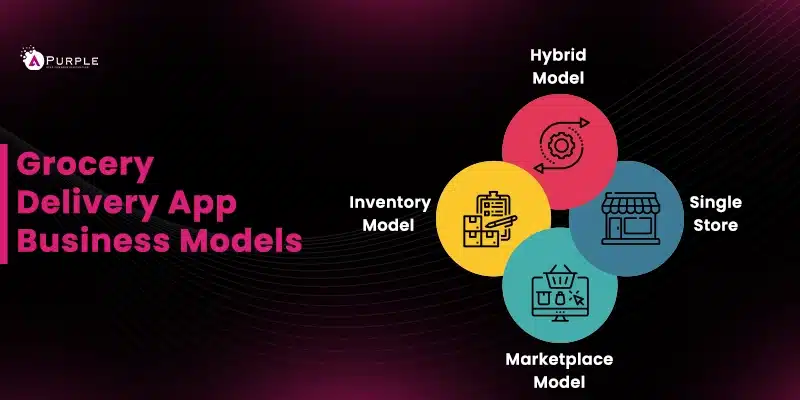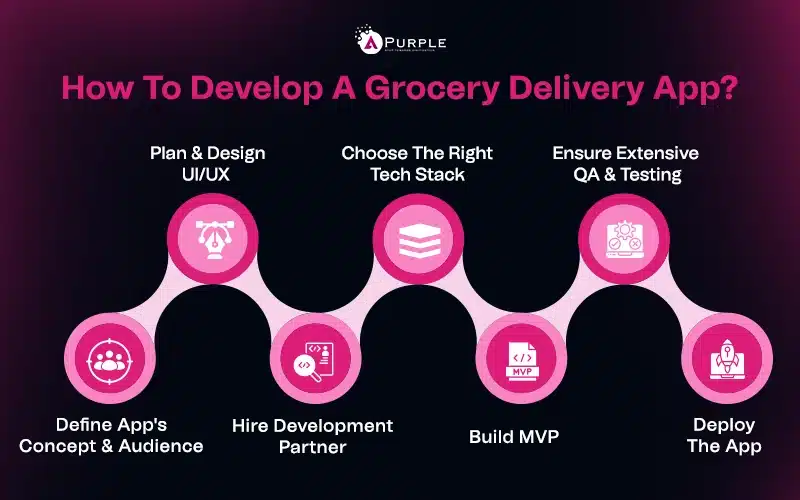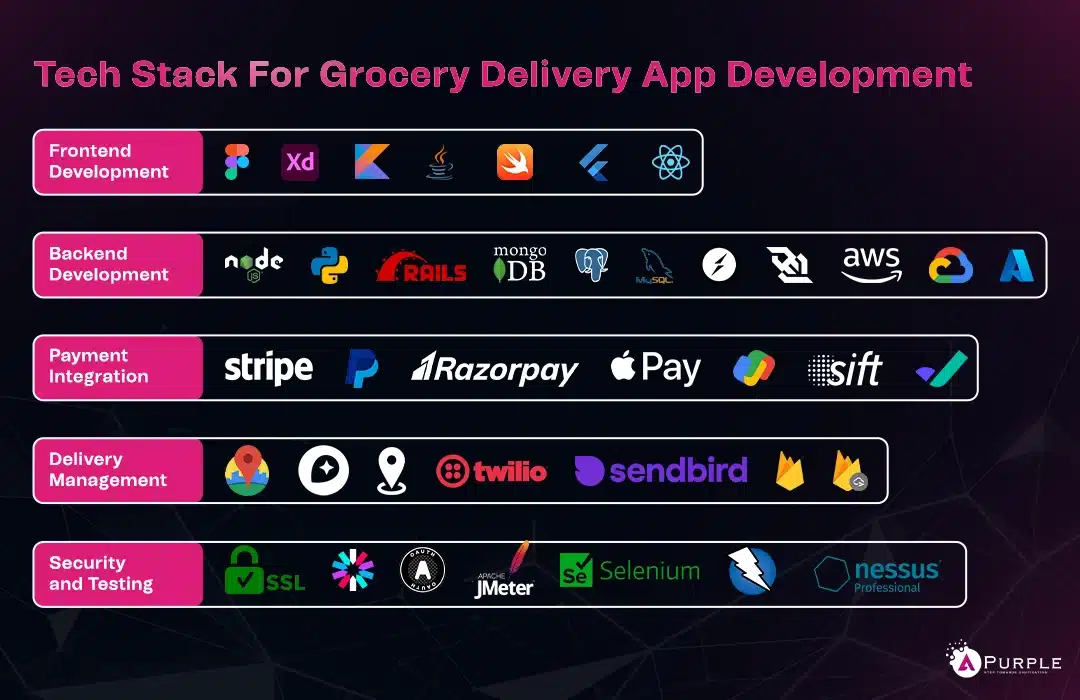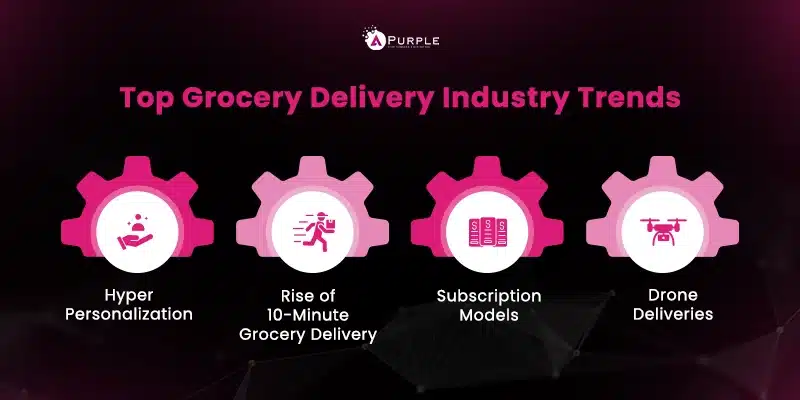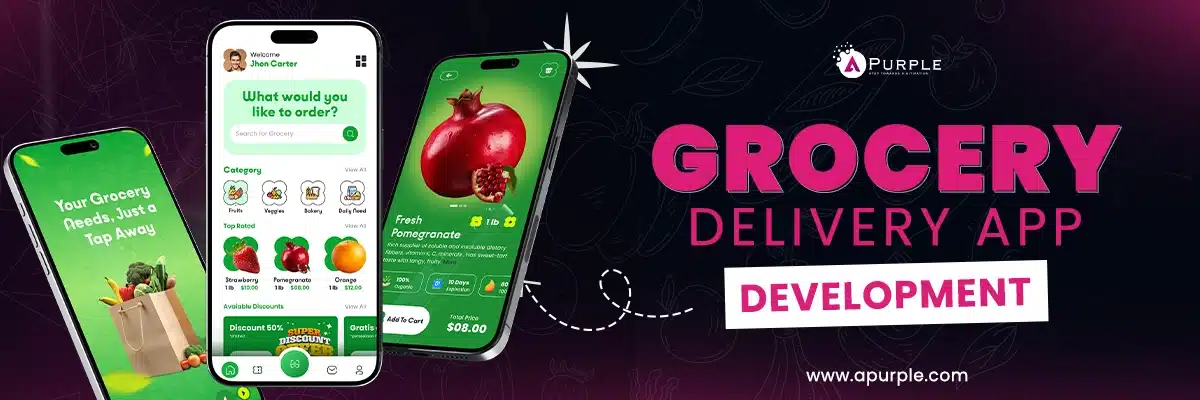
Summary
Getting groceries in 10 minutes is the new norm, and as a startup, you may want to take advantage of this trend! However, the recipe for success in grocery delivery needs technical expertise and an understanding of the customer needs. Despite these challenges, startups and entrepreneurs can’t miss the booming quick commerce market. Here is a comprehensive guide that you can’t afford to miss out if you are looking to ace grocery delivery app development.
Over the years, on-demand grocery delivery has gained more traction, with entrepreneurs and startups looking to capitalize on the booming market. With the new trends of 10-minute grocery delivery becoming more mainstream, the demand for such apps is growing.
So, if you are a startup, a smaller grocery store owner, or a large department store chain looking to capitalize on the quick commerce boom, now is the time – you can’t miss it!
However, a significant challenge you may face is the complex development process. Grocery delivery app development is a multi-phase process in which you must plan, design, develop, test, and deploy the application. Coping with the complexities of designing and developing an app that can compete with existing market leaders needs a strategic approach.
Fret not – we are here to help! Our team of experts at aPurple, with a combined average experience of over 10 years and a proven record of delivering over 800 projects, including several grocery apps, has developed a comprehensive guide. This guide will give insights into grocery delivery app development opportunities and project implementation. It also includes features, benefits, revenue models, and development processes.
So, empty your bags full of queries – it’s gonna be full of answers by the end!
What Is A Grocery Delivery App?
Grocery delivery apps are digital marketplaces where users can browse, order, and receive groceries through an app. They are platforms that help users connect with different brands to order groceries. Plus, the ease of online payments makes the entire experience of buying groceries smoother.
Access to new revenue sources is another key aspect that makes custom grocery delivery app development attractive for entrepreneurs or startup owners. To do this, you must understand how the app works and how you can use it to increase your profits.
How Does An On-Demand Grocery Delivery App Work?
A grocery delivery platform has a streamlined flow of how customers can order and deliver the items.
Here’s how it works.
As the above image shows, customers browse for groceries and place orders on the app. Once the order is placed, aggregators or store owners prepare it. Meanwhile, a delivery person to the nearby customer’s location is notified. So, the delivery person will pick up the order and deliver it to the customer’s location.
Now that you know how it works, a significant query that you will have is “WHY?”
Why should you consider developing it, and for whom does investing in the grocery apps make sense?
Why And Who Should Build A Grocery App?
The boom in the online grocery delivery market is mainly due to the immense benefits it offers businesses. This article addresses the why aspect and provides insight into the key drivers of grocery app development for startups.
Why Develop A Grocery App?
Here are the key reasons to build a grocery application,
1. Optimized Operations
Handling processes like inventory management, customer communication, and goods management manually can be time-consuming and prone to human error. These operations streamline the supply chain and reduce errors, saving time and costs.
2. Loyalty programs
Your businesses will be sustained if your customers remain on the platform long-term, so customer loyalty is essential. A grocery app offers loyalty programs on certain products to attract customers. From that, they get reward points or discounts on purchases, which make them buy more and stay on the app.
3. Increase Revenue Streams
Besides direct sales, grocery apps provide additional revenue streams like subscription models, delivery fees, and in-app advertising. You can diversify income sources and grow your revenue through different monetization strategies.
4. Improves Branding
Apps are crucial to building your brand’s image in the digital world. It displays the tagline, logo, distinctive features, and design. Additionally, users must press the app’s logo to open it after downloading it. As a result, individuals become aware of the brand and recall it anytime they see the logo.
All these are just the tip of the iceberg. There are several other benefits to developing an on-demand grocery delivery app. But who can benefit from a grocery app? Here are the key stakeholders that gain from grocery app development
Who Should Develop A Grocery App?
- Supermarket Chains can build grocery apps to enhance customer engagement and streamline operations.
- Delivery and Courier Services and established logistics networks can integrate grocery delivery services to leverage digital transformation and expand their offerings.
- Small And Medium-Sized Grocery Stores can leverage mobile app development to improve the shopping experience and personalize services.
Knowing who should build a grocery app and why to develop it determines your project goals, user flow, and other aspects. For example, user flow for your app will depend on different features and key touch points. Understanding these features will help you better gauge user flow and plan the development process accordingly.
Key Features Of Grocery Delivery App
Grocery delivery apps must offer seamless experiences to stay competitive and meet customer expectations. So, you must consider the impact of features across stakeholders: customers, stores, and delivery personnel.
Here are the key features across stakeholders,
A. Features For Customers
| Features | What It Offers | Cost (USD) |
|---|---|---|
| User Registration/Login | Simple login via email, phone, or social media to create user profiles. | 1,000 – 2,000 |
| Search & Filter Options | Advanced search filters for products, categories, and preferences. | 1,500 – 2,500 |
| Order Tracking | Real-time tracking of orders with delivery time estimates. | 2,500 – 4,000 |
| Multiple Payment Options | Integration of cards, wallets, UPI, and COD options for flexible payments. | 3,500 – 5,000 |
| Push Notifications | Alerts for order updates, discounts, and personalized recommendations. | 2,500 – 3,500 |
| In-App Chat Support | Chat system to resolve queries related to orders or app usage. | 4,000 – 5,000 |
| Wishlist & Cart Management | Add favorite items to a wishlist and manage the shopping cart efficiently. | 2,000 – 3,500 |
| Review & Ratings | Customers can provide ratings and reviews for products and delivery. | 2,500 – 4,000 |
B. Features For Store
| Features | What It Offers | Cost (USD) |
|---|---|---|
| Store Registration & Profile | Easy onboarding for stores with profile creation and verification. | 2,500 – 4,000 |
| Product Management | Add, update, and manage product listings, inventory, and pricing. | 4,000 – 5,500 |
| Order Management | Dashboard to accept, process, and monitor customer orders. | 3,500 – 5,000 |
| Inventory Alerts | Notifications when product stock is low or needs restocking. | 2,500 – 3,500 |
| Payment Management | Track all payments, commissions, and settlement cycles in a unified interface. | 3,000 – 4,500 |
| Analytics & Reporting | Insights on sales, customer behavior, and trends for business optimization. | 4,000 – 5,500 |
| Discount & Coupon Management | Feature to create promotions, offers, and discounts for customers. | 2,500 – 4,000 |
| Order History Management | Easy access to past orders for business tracking and performance. | 2,000 – 3,500 |
C. Features For Driver
| Features | What It Offers | Cost (USD) |
|---|---|---|
| Delivery Agent Registration | Onboarding feature for drivers with profile verification and approval. | 2,500 – 4,000 |
| Real-Time Order Notifications | Receive notifications for new delivery requests and updates on assigned orders. | 2,500 – 3,500 |
| Route Optimization | AI-powered optimized routes for faster and fuel-efficient deliveries. | 4,000 – 5,500 |
| Accept or Reject Orders | They can accept or reject the order as per their availability and provide a reason in case of order rejection. | 2,500 – 3,500 |
| Chat with Customer | Communicate with customers or stores via chat/call for any order-related clarifications. | 4,000 – 5,500 |
| Earnings Dashboard | Track daily earnings, delivery count, and payment settlements. | 3,000 – 4,500 |
| GPS Tracking | Integrated maps for live navigation and real-time location sharing. | 4,000 – 5,000 |
| Feedback System | Option for delivery agents to share feedback about stores or customers. | 2,000 – 3,500 |
While features define a grocery delivery app’s usability, business models shape its purpose and profitability.
4 Business Models For Grocery Delivery Apps You Can Use!
Here are four types of startup business models for grocery app development projects,
1. Single Store
The single-store model works best for grocery store owners. Customers order directly through the app, and the store manages everything from product listings to delivery. This approach eliminates intermediaries, giving the store owners complete control. For example, Kroger provides delivery services through its website and app, allowing customers to order groceries directly from their local Kroger store.
2. Inventory Model
The inventory model allows grocery aggregators to purchase products in bulk from various vendors and store them in their warehouses. Then, they sell these products directly to customers via an app, branding the packaging with their logo. For example, Gopuff stores products in its micro-fulfillment centers, enabling quick customer deliveries.
3. Marketplace Model
The marketplace model connects customers with multiple grocery stores without needing inventory management. If you are a marketplace aggregator, this model helps earn revenue through commissions, subscriptions, or delivery fees.
For example, Instacart partners with multiple retailers and allows customers to order groceries from different stores through its app.
4. Hybrid Model
The Hybrid model combines the Inventory and Marketplace models, allowing you to manage inventory for select products while partnering with local stores to expand your offerings. Essential items are stored in warehouses for quick delivery, while specialty products are sourced from partners. For example, Amazon employs a hybrid model by selling products directly from its inventory and facilitating sales from third-party sellers on its platform.
Read also: Ultimate Guide to Hybrid App Development
Now that the business model is decided, it’s time to develop the grocery app. Here is how to build a grocery app.
7 Steps To Develop A Grocery Delivery App
Here’s a step-by-step guide to simplify the process for you.
Step 1: Define Your App’s Concept and Target Audience
Identifying the target audience and ensuring requirements are analyzed helps a startup plan the grocery app development project. It will help you address the following questions,
- Who are you building the app for?
- What are the unique problems that the app will solve?
- What features will it offer?
- How will it make money?
To answer the above questions and plan the entire project through the following process,
- Identify your target audience and their pain points.
- Outline the unique problems your app will solve.
- Define core features and revenue model.
- Create a detailed Product Requirement Document (PRD) covering app features, stakeholders, and goals.
- Conduct market research to prioritize essential features and address market gaps.
Step 2: Plan Your App’s UI/UX Design
Designing your grocery app is the project’s next and most crucial step. It ensures that your app has a sound visual representation. The user interface (UI) of your app will act as a gateway for users to interact with your business.
- Use a clean, minimalistic grocery delivery app design for seamless navigation.
- Design your app to access product categories, cart, and tracking easily.
- Minimize time needed to complete orders through minimal UI design.
- Make your app design more personalized through unique dUI elements.
Step 3: Hire a Grocery Delivery App Development Company
The complexities of designing and then implementing the same for your application through quality development need expertise. However, choosing a grocery delivery app development company requires the following steps,
- Choose a company with experience in grocery delivery app development.
- Evaluate portfolios, past projects, and expertise.
- Opt for a provider offering end-to-end customized solutions.
Step 4: Choosing the Right Tech Stack
The next step is to choose the right technology stack for your project. However, choosing the right tech stack needs expertise; this is where a grocery app development company can help.
Here are some tips for choosing the right tech stack,
- Align technology with app goals for scalability and performance.
- Use cross-platform tools like Flutter or React Native for MVPs and Swift/Kotlin for native apps.
- Select robust backend technologies for data, security, and integrations.
- Incorporate third-party APIs for navigation, payments, and notifications.
- Opt for cloud solutions to manage future traffic growth efficiently.
Step 5: Build the MVP (Minimum Viable Product)
Once you choose the tech stack, it’s time for development! However, testing a mini version of your grocery app, which includes the core features, can help reduce errors, risks, and costs before you build a full-fledged application. This mini version is called an MVP.
Here are the key steps to develop, test, and improve the app,
- Start by developing an MVP with essential features to test app functionality and concept.
- Gather user feedback to refine the app.
- Save time and cost by improving the app based on real-world feedback before the launch.
Step 6: Quality Assurance and Testing
When using the MVP approach, testing is a continuous process. You can test the MVP and add feedback-based changes to the app in the next version. Before releasing the next version, you can test it for more feedback and bugs.
Here is how to implement the testing process,
- Perform functional testing to ensure features work as planned.
- Conduct performance tests for responsiveness during high traffic.
- Run compatibility tests across devices and OS.
- Beta tests with real users to identify and fix issues in real-world scenarios.
Step 7: Deployment and Support
Again, the deployment step is continuous, with each app version being deployed on target platforms like Android and iOS. You must also plan the support and maintenance activities required throughout the mobile app development lifecycle.
Here is the process to follow for the deployment and maintenance of your grocery app,
- Launch the app on the targeted app store.
- Continuously monitor performance and fix bugs.
- Regularly update the app with new features.
- Ensure compatibility with system updates.
- Provide ongoing maintenance to meet evolving user needs and market demands.
The entire grocery app development process relies on strategic implementation and the right technology stack.
Tech Stack Selection For On-Demand Grocery Delivery App Development
The app’s functionality relies on the right technology stack. A well-chosen stack supports scalability, innovation, and long-term success.
Here are the essential technologies for the grocery app development project.
A. Tech Stack For Frontend Development
| Task | Tech Stack | Purpose |
|---|---|---|
| UI/UX Design | Figma, Adobe XD | Designing an appealing user interface |
| Android App Development | Kotlin, Java | Developing Android-specific app features |
| iOS App Development | Swift, Objective-C | Building the iOS version of the app |
| Cross-Platform App | Flutter, React Native | Creating apps that work on both iOS and Android |
B. Tech Stack for Backend Development
| Task | Tech Stack | Purpose |
|---|---|---|
| Server-Side Programming | Node.js, Python, Ruby on Rails | Handling app logic and backend processes |
| Database Management | MongoDB, PostgreSQL, MySQL | Storing user data, product details, and orders |
| Real-Time Updates | Socket.IO, WebSockets | Enabling real-time order tracking and notifications |
| Cloud Services | AWS, Google Cloud, Azure | Hosting, storage, and scalability |
C. Tech Stack For Payment Integration
| Task | Tech Stack | Purpose |
|---|---|---|
| Payment Gateway Integration | Stripe, PayPal, Razorpay | Enabling secure online payments |
| Digital Wallets | Apple Pay, Google Pay | Adding alternative payment options |
| Fraud Detection | Sift, Riskified | Preventing payment fraud and ensuring safety |
D. Tech Stack for Delivery Management
| Task | Tech Stack | Purpose |
|---|---|---|
| Map & Navigation | Google Maps API, Mapbox | Providing delivery routes and location tracking |
| Real-Time Tracking | GPS, Geolocation APIs | Tracking orders and delivery agent movements |
| In-App Chat & Messaging | Twilio, SendBird, Firebase | Allowing real-time communication between users, delivery agents, and stores |
| Notifications | Firebase Cloud Messaging, Twilio | Sending alerts for order updates and delivery status |
E. Tech Stack for Security and Testing
| Task | Tech Stack | Purpose |
|---|---|---|
| App Security | SSL Certification, JWT, OAuth | Ensuring data privacy and secure logins |
| Performance Testing | Apache JMeter, Selenium | Checking app speed and efficiency |
| Penetration Testing | OWASP ZAP, Nessus | Detecting and resolving security vulnerabilities |
The right tech stack ensures your grocery delivery app operates seamlessly, scales effortlessly, and provides an exceptional user experience.
By aligning your budget with your business goals, you can prioritize these technologies to build an app that meets customer expectations while staying ahead of the competition.
How Much Does It Cost To Develop a Grocery Delivery App?
The development cost of a grocery delivery app can start from USD 18,000 (cost for MVP app) and can exceed USD 300,000 for an advanced app integrated with AI features.
The cost depends on factors other than the type of app. It also depends on the kind of development team you choose and their location.
Let’s look at the details, as this may help you budget your project.
| Type of team | Hourly rate |
|---|---|
| In-House (Senior developers) | USD 150+ |
| Local agency | Around USD 75 |
| Freelancers (Experienced) | USD 50 to USD 75 |
| Outsource agency | USD 18 to USD 50 |
Do you see that?
The best option is Outsourcing, which starts at the lowest price, and you get experience and expertise for that price.
But here’s a catch!
The table shows that the cost of outsourcing can reach up to USD 50, mainly due to the location. Yes, location matters; in some countries, the hourly rates are comparatively lower. Let’s examine the cost of outsourcing based on the area.
| Location | Hourly rate |
|---|---|
| USA | USD 150+ |
| INDIA | USD 18 |
| UKRAINE | USD 40 |
| MEXICO | USD 50 |
Understanding the related costs will help you plan the budget before starting the grocery mobile app development process. Knowing the expenses also includes considering feature complexity. However, feature complexity is not always about what technology you may need to develop it. Several factors can impact complexity, including trends in the grocery delivery industry.
4 Online Grocery Delivery Industry Trends
Here are the new trends that will redefine grocery delivery businesses,
1. Hyper-Personalization is Taking Center Stage
If you’ve used a grocery delivery service, you’ve probably received notifications about your favorite snacks or frequently purchased items. This personalization is driven by artificial intelligence, which learns from user preferences and behaviors to offer intelligent recommendations.
It allows for tailored reminders and offers that cater to individual needs, enabling startups to develop apps that better understand their customers.
2. Rise of 10-Minute Grocery Delivery
Walking around the UK, you’ll find numerous outdoor advertisements from startups promising grocery deliveries in 10 minutes or less. Brands like Getir, GoPuff, Zapp, and Gorillas compete in this rapidly growing market.
Speed has always been a competitive advantage, and 10-minute deliveries are becoming a reality. In 2021, Deliveroo partnered with Morrisons to launch Hop, a service that delivers groceries in just 10 minutes.
Quick-commerce platforms are already pushing the limits of fast delivery, with micro-warehouses emerging in densely populated areas. This trend is expected to grow even more in the coming years, driven by advancements in drones, AI-driven logistics, and the increasing demand for “instant everything.”
3. Subscription Models Will Dominate
Subscription models are booming and will not disappear. Apps like Instacart and Amazon Fresh have shown how monthly memberships can drive customer loyalty while offering perks like free delivery, exclusive discounts, and priority slots.
4. Drone Deliveries
Drone technology is becoming a reality in grocery delivery. Walmart and Amazon are already piloting drone services for faster, contactless delivery in urban and hard-to-reach areas. For startups, embracing drone technology offers a significant opportunity to provide innovative and eco-friendly grocery delivery solutions.
As the industry evolves, investing in feature-rich, on-demand grocery delivery apps is essential for delivering exceptional value and maintaining a competitive edge.
Choosing one of the grocery app development trends requires analyzing its potential challenges. For example, if you are developing a grocery app, you need to consider the challenge of managing inventory.
Grocery Delivery App Development Challenges And Solutions
Here are some key challenges and solutions,
1. Inventory Management
Managing real-time inventory is essential to prevent scenarios such as stock shortages, excessive inventory, or incorrect app updates. Customers consistently anticipate precise availability and prompt updates.
Solution
Use tools such as barcode scanners and IoT-enabled devices. Connect directly to the store’s data via APIs to automate stock updates, enabling efficient demand and inventory replenishment anticipation.
2. Handling High Traffic During Peak Demand
During peak hours like evenings and weekends, the system may become overloaded, leading to slow performance or crashes. This situation frustrates users, results in lost sales, and can contribute to users abandoning the app.
Solution
Use cloud-based architecture to scale resources dynamically during peak traffic times. Apply load balancing to distribute traffic evenly among various cloud servers. Perform stress tests before launch to ensure the app is prepared for maximum loads.
3. Complex Product Catalogs
Grocery apps typically feature extensive catalogs with various types, brands, and prices. However, a cluttered interface can complicate user search and navigation.
Solution
The key is to optimize user experience by maintaining a clear and concise UI. Organize catalogs with user-friendly filters, categories, and AI-based recommendations to improve the shopping journey.
4. Perishable Goods Management
Vegetables, dairy, and meat require fresh delivery because they have short shelf lives. Consumers who receive expired or spoiled food items may lose trust in your platform.
Solution
To enhance your grocery delivery app, consider these strategies:
- Offer discounts on near-expiring items to reduce waste.
- Plan delivery time slots to minimize storage time and ensure quick service.
- Use temperature monitoring systems during transit to keep items fresh.
Addressing these points allows your app to meet user expectations and stand out in a competitive market.
How Is aPurple the Best Grocery App Development Company for Your Project?
aPurple is a leading grocery app development company that has helped startups identify potential business opportunities and build profitable platforms. Experts from our team have built reliable on-demand solutions for clients according to their use cases.
1. A Grocery App For 10-Minute Quick Delivery
A client from Riyadh wanted to replicate the 10-minute quick commerce business model prevalent in South Asian markets. Our team helped the client build native apps for Android and iOS, customizing them according to business requirements. With real-time tracking capabilities and route optimization features, the apps helped the startup execute 10-minute deliveries efficiently.
2. Grocery Store App That Caters To 15K Customers Per Day
Departmental grocery stores are now looking to create a delivery app for their businesses. When one such client turned to aPurple for a grocery app development project, the idea was to automate key operational tasks. For example, the grocery store was looking to manage inventory and make delivery faster through the app.
Our team used our expertise to develop on-demand grocery delivery applications to create a reliable platform. We helped clients with advanced features to manage inventory and improve the speed of last-mile deliveries. Our solutions ensure the store can cater to more than 15k customers daily through the app.
The clients, a quick commerce startup and a grocery store, chose our dedicated team to build their platforms.
A dedicated team offers several benefits over options like a fixed scope contract or freelancers. Here is what makes the dedicated team more attractive,
| aPurple | In-House | Freelancer | |
|---|---|---|---|
| Weekend Support | Yes | No | No |
| Dedicated Resources | Yes | Yes | No |
| Termination Cost | No | High | No |
| Project Manager Cost | No | High | No |
| Query Support | 24×7 | High | No |
| Time to Start a Project | 1 Day – 2 Weeks | 2 – 10 Weeks | 1 – 10 Weeks |
| Hiring Model | Monthly, Part & Full Time | Full Time | Weekly, Hourly |
| Recurring Cost of Training & Benefits | 0 | 10K – 30k USD | 0 |
| Time to Scale Size of the Team | 48 Hours | 4 – 16 Weeks | 1 – 10 Weeks |
| Availability 24×7 | Seamless | Seamless | Uncertain |
| Agile Development | Yes | Maybe | No |
| Free Trial | 7 Days | No | No |
Conclusion
A grocery delivery app addresses operational challenges and fosters business growth for startups. However, startups, department stores, and large store chains face challenges in developing grocery delivery apps. So, if you are a startup looking to build a grocery app, you need experts who understand the market and navigate development challenges.
aPurple offers end-to-end mobile app development services, from consultation and development to testing and post-launch support. With over a decade of experience and a proven track record, our team turns complex ideas into scalable solutions.
Whether starting from scratch or enhancing an existing app, aPurple is here to help. Let’s build a standout grocery delivery app that grows with your success. Contact us today!
FAQ
The cost of developing an on-demand grocery delivery app can range from $18,000 for an MVP to more than $200,000 for an advanced app integrated with AI features.
An MVP grocery mobile app takes 1 to 1.5 months to develop, while an advanced app takes more than 9 months to build.
A grocery delivery app allows users to register on the platform, browse and select groceries from the catalog, add them to a cart, and select a payment mode. The store then receives and processes the order, and a designated delivery executive picks up the items from a partnered grocery store and delivers them to the customer’s door.
On-demand grocery delivery app development involves building a mobile application that allows users to quickly buy groceries from a nearby store and deliver them to their doorstep.
A top grocery delivery app development company should combine expertise, creativity, and a track record of success. With over ten years of experience, aPurple offers scalable, user-focused grocery app solutions.

